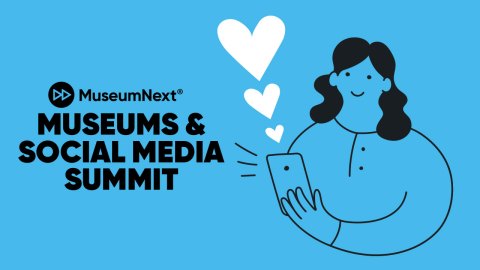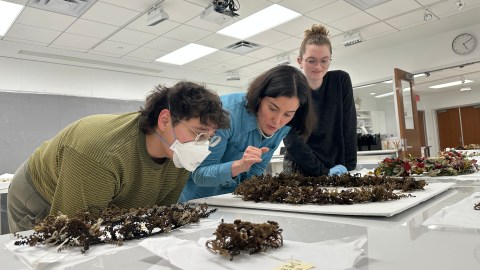
This visual Data Story is based on findings from the 2024 Annual Survey of Museum-Goers, a national survey of American museum visitors from AAM and Wilkening Consulting. Every year, the survey partners with individual museums to research their audiences and yield insights about their behaviors and preferences, both on an institutional and national level. Interested in joining the 2025 edition on the themes of repeat visitation, social connection, and community trust and responsibility? Sign up by February 28, 2025, for a special early bird rate.

Across the country, millions of children get up and head to their home classrooms. These homeschooled children are primarily learning from their parents and guardians in a rather different environment than children in formal education (like public, private, and charter schools). And they are also a niche audience that many museums specifically serve.
In the 2024 Annual Survey of Museum-Goers we asked parents and guardians of school-age children what types of schools their children attended. Overall, here’s what we found:
- Public school: 72%
- Charter school: 7%
- Private school: 19%
- Homeschool: 11%
Parents and guardians could choose more than one answer, since siblings could be enrolled in different types of educational environments.
The latest data from the National Center of Education Statistics(2) (2021) says 6.8% of households with children homeschool at least one child. Note, however, they are counting all households with children, including those with very young children and infants. This suggests that if the households with children 4 and younger were removed from the calculation, the percentage of homeschooling households with school-age children would likely be in the 8 – 10% range…close to what we found.
In total, 1,178 museum-going homeschooling households responded to our survey…a truly robust sample of this specific audience.(1) Let’s explore what they shared with us.
Characteristics of Homeschooling Families
For the most part, homeschooling families are a lot like families whose children participate in formal education. In fact, a quarter of homeschooling families also have children in public, private, or charter schools, indicating that for some homeschool households, homeschooling decisions are made on a child-by-child basis.
Families choose to homeschool for a variety of reasons, and they hold diverse values.
That said, overall there were significant differences that set homeschool families apart:
- Education. Homeschooling parents and guardians generally have lower levels of educational attainment: they were a third less likely to have a graduate degree, and 70% more likely to have not completed college.
- Political Values. These households were 2.6x more likely to identify as conservative, and only half as likely to identify as liberal, than other parents and guardians. Overall, 35% identified as conservative and 25% liberal.
- Religious Values. While we didn’t explicitly ask about religion, homeschool respondents were nearly twice as likely to cite their religion or faith as giving them hope, suggesting stronger religious ties than other respondents.
There were no meaningful differences by race and ethnicity.
We don’t ask about income or employment status in our research, but data from the National Center of Education Statistics indicates that households that homeschool tend to have lower average income, likely because they are more likely to have a stay-at-home parent or guardian.
Thus, it wasn’t a big surprise to see that homeschool families were much more likely to say their membership makes visiting museums cost-effective, and to cite the cost of museum visits as a barrier to more frequent visitation.
“Cost: at the time it was affordable enough for us to attend.”
“Creates an affordable outing for me to take my kids to.”
Museum Visitation and Motivations
To our surprise, homeschool families don’t visit museums any more frequently than families participating in formal education. Visitation rates are about the same.
This doesn’t preclude some super-users of museums among homeschooling households…just that they are outliers (the same is true for families with kids in formal education).
Generally, their motivations are similar as well in that virtually all parents and guardians are focused on their children’s experiences. That said, homeschool families are even more likely to have laser-like focus on learning experiences for their children (80% versus 66% for other families). But they are somewhat less likely to visit for family time.
Homeschooling families tend to be a bit more critical of museums overall, being somewhat more demanding of additional content and less likely to say museums are doing a “great job” than other families.
“We are interested in genealogy and local history so we are hoping to learn how our membership can assist with that as well as local history for a homeschooling high school elective.”
“[Museums should] offer classes specifically for homeschool children.”
Community Orientation
Homeschool families were generally less enthusiastic about response choices that had a community theme. That is, they were significantly less likely to say:
- Museums contribute to the quality of life in their community
- That visiting museums makes them feel more a part of the community
- That being part of a community of people working to make things better gave them hope
This greater sense of separation from community may be deliberate for at least some homeschooling families. According to the National Center of Education Statistics, the top reason for homeschooling children is concerns about the school environment and other students.
Inclusion
Perhaps the most significant difference between homeschool families and families with children enrolled in formal education is their attitude towards inclusive content. Homeschooling parents and guardians are about 2.5x more likely to fall in the “anti-inclusive” segment than other parents and guardians, as seen below:

Additionally, homeschool parents and guardians were far less likely to identify as an ally of the LGBTQ+ community, only 20% versus 34% of other parents and guardians.
Some of the comments from less inclusive homeschooling parents and guardians were strongly worded. While we have chosen not to share the more offensive comments, the following two quotes provide a glimpse of the sentiments of a significant portion of homeschool parents and guardians.
“Being able to visit AND take my kids without being afraid of extreme wokeness or being told how racist, etc. Things are out of control. Can we please go back to educating society
without this craziness?”“Any attempt to be inclusive this day and age there are people left out. I don’t want to visit a museum to have varying agendas pushed down my throat.”
Learning Learning Learning
Consistently, homeschool families hammered home how important the learning experience was for their children. In particular, they were significantly more likely to want museums to take a fact-based approach and minimize interpretation and what they articulated as “opinion.” Instead, they wanted to use those facts to draw their own conclusions.
“We used to love the museum–stick to presenting facts, not controversial social or political opinions.”
That said, they were not necessarily seeking a dry recitation of facts. Strong majorities of homeschool families wanted:
- To develop greater understanding of the experiences of people from the past through historical imagination
- To inspire curiosity to wonder and learn on their own
- To see things that inspire awe or wonder
“To see and experience beauty, so we can be expanded in our views of what is possible and have our wonder awakened.”
“Hands-on experiences, this is especially true for kids or tactile learners. Focus on truth and beauty, these things inspire wonder and awe which can lead to a lifetime of curiosity.”
So what have we learned about homeschooling families? Some of the results surprised us, including that homeschool families, on average, don’t visit museums any more frequently than other families. Other results fit into our expectations, including their even greater focus on child learning as well as their “just the facts” approach to content.
There are two areas of concern, however: their lower levels of community connection and their generally less inclusive attitudes. This suggests that, when planning homeschool events, museum educators need to consider more thoughtfully how they are sharing content that reflects different life experiences and worldviews, as at least some homeschooled children may not have been exposed to those ideas yet. Audiences and Inclusion: A Primer for Cultivating More Inclusive Attitudes Among the Public provides guidance for doing just this work.(3)
That said, keep in mind that parents and guardians have many reasons they choose to homeschool, and we need to be careful to not make assumptions. While the majority of homeschool families may fall on the anti-inclusive side of the spectrum, a third fall on the inclusive side. Some parents and guardians choose to homeschool because schools are not inclusive enough, or perhaps because their children are gender diverse or transgender and they want to provide a more supportive environment. And others homeschool because their children are medically fragile.
Bottom line, millions of families are choosing to homeschool, making reaching this audience, and these children, important for many museums. Additionally, museums can do a great deal to help these children learn more about their communities and the world they live in.
Annual Survey of Museum-Goers Data Stories are created by Wilkening Consulting on behalf of the American Alliance of Museums. Sources include:
- 2024 Annual Survey of Museum-Goers, n = 90,178; 202 museums participating
- 2024 Broader Population Sampling, n = 2,154
- 2017 – 2023 Annual Surveys of Museum-Goers
*Data Stories share research about both frequent museum-goers (typically visit multiple museums each year) and the broader population (including casual, sporadic, and non-visitors to museums).
- We did not ask this question of parents and guardians in our broader population sample of U.S. adults, only of frequent museum-going families.
- See the National Center for Education Statistics “Homeschooled Children and Reasons for Homeschooling” for more information on homeschooling families.
- You can download a copy at the AAM or Wilkening Consulting websites.
More Data Stories can be found at wilkeningconsulting.com/data-stories.








